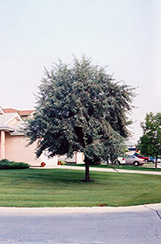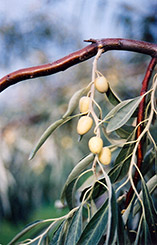Height: 20 feet
Spread: 15 feet
Sunlight:
![]()
Hardiness Zone: 3a
Description:
An excellent small tree for colour contrast use, with silver foliage all season long, dark grey trunk; small, fragrant, yellow flowers in Spring and small silver berries in Fall; long sharp thorns; an excellent choice for dry, well-drained sites
Ornamental Features
Russian Olive has attractive silver deciduous foliage on a tree with a round habit of growth. The fuzzy narrow leaves are highly ornamental but do not develop any appreciable fall colour. It features subtle fragrant lemon yellow bell-shaped flowers along the branches in late spring. The peeling brown bark and silver branches add an interesting dimension to the landscape.
Landscape Attributes
Russian Olive is an open deciduous tree with a more or less rounded form. Its relatively fine texture sets it apart from other landscape plants with less refined foliage.
This tree will require occasional maintenance and upkeep, and is best pruned in late winter once the threat of extreme cold has passed. Deer don't particularly care for this plant and will usually leave it alone in favor of tastier treats. Gardeners should be aware of the following characteristic(s) that may warrant special consideration;
- Spiny
Russian Olive is recommended for the following landscape applications;
- Accent
- Shade
- Hedges/Screening
Planting & Growing
Russian Olive will grow to be about 20 feet tall at maturity, with a spread of 15 feet. It has a low canopy with a typical clearance of 4 feet from the ground, and is suitable for planting under power lines. It grows at a medium rate, and under ideal conditions can be expected to live for 50 years or more.
This tree should only be grown in full sunlight. It prefers to grow in average to dry locations, and dislikes excessive moisture. It is considered to be drought-tolerant, and thus makes an ideal choice for xeriscaping or the moisture-conserving landscape. It is particular about its soil conditions, with a strong preference for clay, alkaline soils, and is able to handle environmental salt. It is highly tolerant of urban pollution and will even thrive in inner city environments. This species is not originally from North America.



